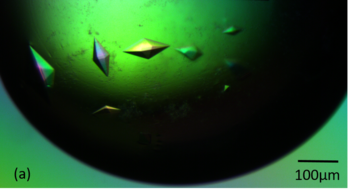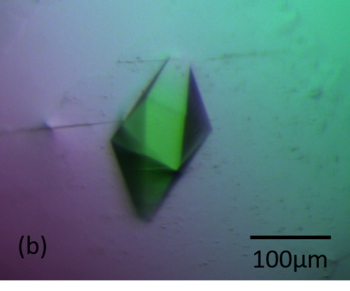Journal:IUCrJ:S2052252521005340
From Proteopedia
(Difference between revisions)

| Line 8: | Line 8: | ||
Anti-HIV antibody RoAb13 targets a short N-terminal region of the protein CCR5, which is the main entry receptor of HIV into the human organism. Blocking that receptor would therefore prevent HIV infection and replication. We had earlier reported the structure of the antibody alone by X-ray crystallography (Chain ''et al.'' 2015<ref name="Chain">PMID:26030924</ref>), but the structure of the antibody complexed to the part of CCR5 to which it binds (its epitope) had remained elusive. That structure is important for designing efficient vaccines based on short synthetic immunogenic peptides that mimic the CCR5 antibody-binding region. | Anti-HIV antibody RoAb13 targets a short N-terminal region of the protein CCR5, which is the main entry receptor of HIV into the human organism. Blocking that receptor would therefore prevent HIV infection and replication. We had earlier reported the structure of the antibody alone by X-ray crystallography (Chain ''et al.'' 2015<ref name="Chain">PMID:26030924</ref>), but the structure of the antibody complexed to the part of CCR5 to which it binds (its epitope) had remained elusive. That structure is important for designing efficient vaccines based on short synthetic immunogenic peptides that mimic the CCR5 antibody-binding region. | ||
| - | After a long search for co-crystallisation conditions involving both the whole N-terminal region of CCR5 and the minimally required binding region to its antibody (the ‘core peptide’), and the analysis and comparison of X-ray crystallographic electron density maps obtained from several crystals, we have finally located the core peptide of the CCR5 receptor bound to RoAb13. It binds at the hypervariable region ‘CDR3’ of the antibody’s light chain, an expected antigen-binding site. In spite of the fact that the best attainable resolution is not particularly high at 3 Å, we have been able to identify the interacting residues between antibody and peptide. Furthermore, the core peptide was found to bind in a way that can accommodate the full length of the CCR5 N-terminus. | + | After a long search for co-crystallisation conditions involving both the whole N-terminal region of CCR5 and the minimally required binding region to its antibody (the ‘core peptide’), and the analysis and comparison of X-ray crystallographic electron density maps obtained from several crystals, we have finally located the core peptide of the CCR5 receptor bound to RoAb13. It binds at the hypervariable region ‘CDR3’ of the antibody’s light chain, an expected antigen-binding site. In spite of the fact that the best attainable resolution is not particularly high at 3 Å, we have been able to identify the interacting residues between antibody and peptide: |
| + | *<scene name='88/884898/Cv/23'>PIYDIN of the 31 peptide study</scene>. | ||
| + | *<scene name='88/884898/Cv/21'>PIYDIN only study</scene>. | ||
| + | *<scene name='88/884898/Cv/22'>Interacting residues between antibody and peptide PIYDIN. Both cases</scene>. | ||
| + | Furthermore, the core peptide was found to bind in a way that can accommodate the full length of the CCR5 N-terminus. | ||
The structural insights thus may inform the design of better peptide analogues for use as immunogens in vivo. These analogues may ultimately provide the basis for active immunization vaccines to stimulate an antibody response to native CCR5 which will thwart HIV infection. | The structural insights thus may inform the design of better peptide analogues for use as immunogens in vivo. These analogues may ultimately provide the basis for active immunization vaccines to stimulate an antibody response to native CCR5 which will thwart HIV infection. | ||
| Line 32: | Line 36: | ||
*<scene name='88/884898/Cv/10'>The overlay of both with the 31 peptide. 1st view</scene>. The PIYDIN of the 31 peptide study is in orange, the PIYDIN only study is in magenta. | *<scene name='88/884898/Cv/10'>The overlay of both with the 31 peptide. 1st view</scene>. The PIYDIN of the 31 peptide study is in orange, the PIYDIN only study is in magenta. | ||
*<scene name='88/884898/Cv/9'>The overlay of both with the 31 peptide. Orthogonal view</scene>. | *<scene name='88/884898/Cv/9'>The overlay of both with the 31 peptide. Orthogonal view</scene>. | ||
| - | |||
| - | '''Interacting residues between antibody and peptide PIYDIN:''' | ||
| - | *<scene name='88/884898/Cv/23'>PIYDIN of the 31 peptide study</scene>. | ||
| - | *<scene name='88/884898/Cv/21'>PIYDIN only study</scene>. | ||
| - | *<scene name='88/884898/Cv/22'>Interacting residues between antibody and peptide PIYDIN. Both cases</scene>. | ||
<b>References</b><br> | <b>References</b><br> | ||
Revision as of 10:26, 14 June 2021
| |||||||||||
This page complements a publication in scientific journals and is one of the Proteopedia's Interactive 3D Complement pages. For aditional details please see I3DC.


